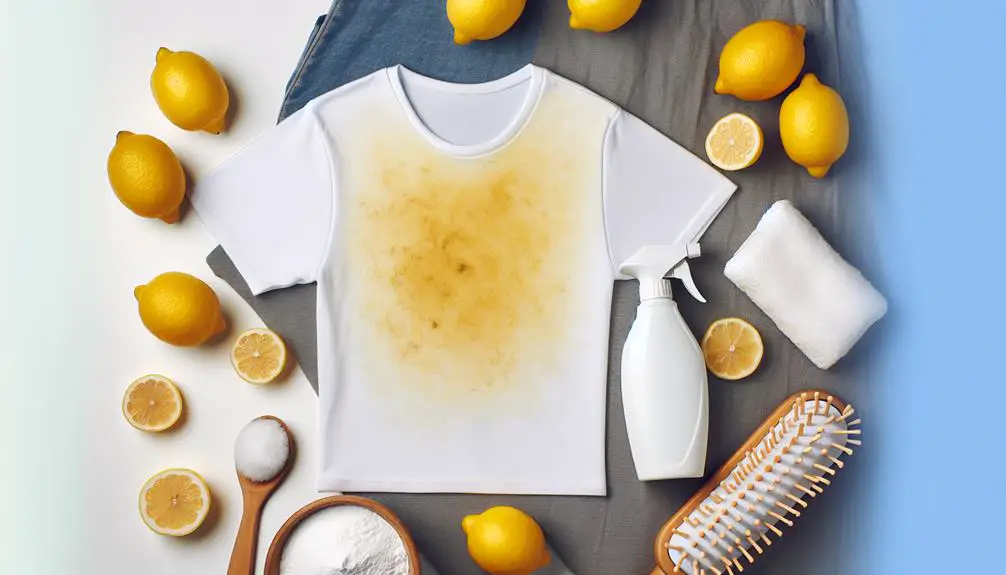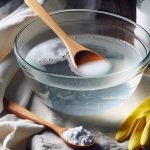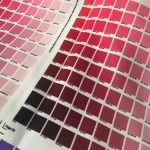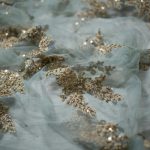I once thought my white clothes were like fresh snow, but over time, they turned as dull as slush. Discovering how to revive them was like finding a hidden treasure in my laundry routine.
From pre-treating stains to using simple household items like white vinegar and baking soda, there are numerous ways to breathe new life into those greyed garments. Each method holds its own promise, but the real magic lies in uncovering which one will truly restore your whites to their former glory.
Table of Contents
Key Takeaways
- Use natural whitening agents like white vinegar and baking soda for eco-friendly and effective results.
- Opt for citrus-based solutions like lemon juice for natural bleaching and fresh scent benefits.
- Consider powerful whitening solutions such as hydrogen peroxide for restoring brilliance without damage.
- Explore additional methods like OxiClean, bluing agents, and following proper care instructions for optimal results.
Pre-Treat Stains
To effectively pre-treat stains on greyed white clothes, I usually dab a small amount of gentle stain remover directly onto the affected areas before throwing them into the wash. This method helps to target and lift stains more effectively during the washing process, making sure that my white clothes come out looking brighter and cleaner. When it comes to stain removal, it's important to act promptly and treat the stains as soon as possible to prevent them from setting in and becoming more challenging to remove later on.
Proper fabric care is essential to maintain the quality and longevity of white clothes. By pre-treating stains before washing, I can make sure that the fabric is treated gently and effectively, minimizing the risk of damage or discoloration. It's important to choose a stain remover that's suitable for the fabric type to avoid any potential harm.
Use White Vinegar
For tackling stubborn stains and brightening greyed white clothes, a simple yet effective solution is using white vinegar. When it comes to laundry, vinegar offers numerous benefits beyond just cooking.
Here are five tips on how to leverage this household staple for whiter whites:
- Natural Bleaching: Vinegar acts as a natural bleaching agent, breaking down stains and discoloration on white fabrics.
- Odor Eliminator: Say goodbye to musty smells as vinegar helps neutralize odors, leaving your clothes fresh and clean.
- Fabric Softener: Enhance the softness of your white garments by adding a splash of vinegar to your rinse cycle.
- Color Brightener: Revive dull whites by soaking them in a vinegar solution before washing to bring back their original brightness.
- Stain Remover: From grass stains to sweat marks, vinegar can tackle a variety of tough stains on white clothing.
Incorporating white vinegar into your laundry routine can be a game-changer, offering a cost-effective and eco-friendly way to keep your white clothes looking their best.
Try Baking Soda
I've discovered that baking soda can work wonders in restoring the whiteness of greyed clothes. Its benefits include being a natural whitening agent and deodorizer.
When applying baking soda, remember to mix it with water to create a paste and gently scrub it onto the affected areas for best results.
Baking Soda Benefits
Using baking soda can work wonders when it comes to brightening up those greyed white clothes, giving them a fresh and clean look in no time. Here are some benefits of using baking soda for DIY laundry and sustainable cleaning:
- Natural Whitener: Baking soda acts as a natural whitening agent, lifting stains and grime from fabrics.
- Odor Eliminator: It helps neutralize and eliminate odors, leaving your clothes smelling fresh.
- Gentle on Fabrics: Baking soda is gentle on fabrics, making it suitable for various types of materials.
- Eco-Friendly: It's an environmentally friendly alternative to harsh chemicals, promoting sustainable cleaning practices.
- Versatile Cleaner: Besides laundry, baking soda can be used for various cleaning tasks around the house.
Give baking soda a try for a cost-effective and eco-conscious laundry solution!
Application Tips
Let's explore some practical tips for applying baking soda to revive your greyed white clothes effortlessly. When using baking soda, remember to add a cup of white vinegar during the rinse cycle to boost its whitening power. Additionally, consider mixing the baking soda with your regular detergent for an extra cleaning punch. To maximize the effects, let your clothes soak in the baking soda solution for at least 30 minutes before washing as usual. Here's a table highlighting the benefits of using baking soda:
| Benefits | Description |
|---|---|
| Whitening Power | Brightens and removes stains effectively |
| Odor Elimination | Neutralizes and freshens fabrics |
| Gentle on Fabrics | Safe for most fabrics, including delicate ones |
For added benefits, avoid using fabric softener when washing white clothes with baking soda, and consider hanging them in sunlight after washing for natural bleaching effects.
Opt for Lemon Juice
When looking to brighten up greyed white clothes, why not opt for lemon juice?
This citrus powerhouse not only has natural whitening properties but also leaves a fresh, zesty scent on your garments.
Plus, it's an eco-friendly alternative to harsh chemicals, making it a win-win for both your clothes and the environment.
Natural Whitening Properties
Consider leveraging the natural whitening properties of lemon juice to brighten greyed white clothes. Lemon juice is a natural alternative that can help restore the brightness of your garments without harsh chemicals. Here are some key points to keep in mind when using lemon juice for whitening:
- Gentle on Fabrics: Lemon juice is safe to use on most fabrics without causing damage.
- Natural Bleaching Agent: The citric acid in lemon juice acts as a mild bleach to lift stains and brighten whites.
- Fresh Citrus Scent: Enjoy a pleasant aroma on your clothes after using lemon juice as a whitening agent.
- Easy Application: Simply dilute lemon juice with water and apply it directly to the greyed areas.
- Sunlight Activation: For enhanced whitening effects, let the lemon juice-treated clothes dry in the sun.
Fresh Citrus Scent
Enhance your garments with a fresh citrus scent by choosing lemon juice as a natural whitening agent. The citrus vitality of lemon juice not only brightens your greyed white clothes but also leaves them smelling revitalized.
Lemons are known for their vitalizing power, making them a fantastic eco-friendly alternative to harsh chemicals. To use lemon juice effectively, mix it with water and soak your clothes before washing them as usual. The natural acids in lemon juice work to break down stains and yellowing, restoring your whites to their former glory.
Plus, the uplifting scent of lemons will linger on your clothes, giving them a vitalizing aroma. Say goodbye to dull whites and hello to citrus-vital, brightened garments!
Eco-Friendly Alternative
To continue the discussion on whitening greyed white clothes, opting for lemon juice as an eco-friendly alternative not only brightens garments but also infuses them with an invigorating citrus scent. When considering eco-friendly solutions and sustainable practices, lemon juice stands out as a powerful ally in restoring the brilliance of your whites. Here are five reasons why it's a fantastic choice:
- Natural bleaching properties of citric acid
- Eliminates odors without harsh chemicals
- Environmentally friendly packaging options
- Cost-effective compared to commercial products
- Biodegradable and safe for septic systems
Use Hydrogen Peroxide
If you're looking to whiten greyed white clothes effectively, hydrogen peroxide can be a versatile and powerful solution. Hydrogen peroxide is known for its effectiveness in brightening white fabrics and removing stains. When using hydrogen peroxide, it's important to follow safe application techniques to achieve the best results without damaging the fabric.
Here are some safe application techniques for using hydrogen peroxide on your white clothes:
| Hydrogen Peroxide Application | Instructions | Benefits |
|---|---|---|
| Pre-Treating Stains | Apply hydrogen peroxide directly to stains before washing. | Helps lift tough stains effectively. |
| Brightening Whites | Mix hydrogen peroxide with water and soak clothes for 30 minutes. | Restores the whiteness of dull fabrics. |
| Adding to Laundry | Pour hydrogen peroxide into the bleach compartment of your washing machine. | Enhances the overall whitening effect. |
Consider OxiClean
Considering OxiClean for whitening greyed white clothes can be a highly effective and convenient solution. OxiClean is known for its powerful stain-fighting properties and can work wonders on dingy white fabrics.
Here are some key points to understand about OxiClean and how it compares to traditional bleach:
- OxiClean Effectiveness: OxiClean is effective in lifting tough stains and brightening whites without causing yellowing or weakening fabric fibers.
- Gentler Than Bleach: Unlike traditional bleach, OxiClean is gentler on clothes and is less likely to cause damage or deterioration over time.
- Versatile Applications: OxiClean can be used in various ways, from pre-soaking to adding it directly to the washing machine, making it a versatile whitening option.
- Color-Safe Option: OxiClean is generally considered safe for use on colored garments, providing a broader range of applications compared to bleach.
- Eco-Friendly Alternatives: For those looking for more environmentally friendly options, there are OxiClean alternatives that offer similar whitening power without harsh chemicals.
Wash With Bluing Agent
When looking to enhance the brightness of greyed white clothes, one effective approach is to incorporate a bluing agent into the washing process. Bluing agents work by adding a subtle blue tint to white fabrics, counteracting the yellowing that can make clothes appear grey. Not only does this help restore the crisp whiteness of your garments, but also gives them a fresher look.
Here are some benefits of using a bluing agent in your laundry routine:
| Bluing Benefits | Fabric Care |
|---|---|
| Counteracts yellowing | Gentle on fabrics |
| Restores brightness | Safe for most materials |
| Enhances whiteness | Doesn't damage clothing |
To make the most out of bluing agents, it is crucial to follow some best practices and laundry tricks. Remember to always dilute the bluing agent according to the manufacturer's instructions to prevent overbluing. Additionally, avoid using bluing on synthetic fabrics as it may not be as effective or could cause discoloration. By incorporating bluing agents wisely, you can revive your greyed white clothes and keep them looking their best.
Frequently Asked Questions
Can I Use Bleach to Whiten Greyed White Clothes?
Yes, bleach can whiten greyed white clothes, but it can also damage the fabric. I recommend exploring bleach alternatives like oxygen bleach or natural solutions like lemon juice or baking soda, which are gentler on clothes.
How Often Should I Whiten My White Clothes Using These Methods?
I wash my white clothes with whitening methods every 3-6 months. Frequent whitening may damage fabrics. It's important to balance fabric care, environmental impact, and cost effectiveness. Keeping a moderate schedule guarantees clean whites without compromising quality.
Will These Methods Work on Delicate Fabrics Like Silk or Wool?
I've found gentle alternatives effective for delicate fabrics like silk. Silk care is important to maintain its beauty. These methods may not be suitable for such fabrics. Always prioritize the specific care instructions provided for silk and wool garments.
Can I Mix Different Whitening Agents Together for Better Results?
Mixing different whitening agents can enhance effectiveness but could also be risky. Always check compatibility and safety precautions before combining products. Testing a small area first is wise to avoid damaging fabrics.
Are There Any Specific Precautions I Should Take When Using Hydrogen Peroxide or Bleach on My Clothes?
When dealing with hydrogen peroxide or bleach on clothes, it's essential to think about fabric safety and color fading. Always test on a small area first, follow care labels, and never mix these agents.
- Recycling Nonwoven Fabrics: Is It Possible? - July 11, 2025
- Recycling Nonwoven Fabrics: Is It Possible? - July 11, 2025
- Recycling Nonwoven Fabrics: Is It Possible? - July 11, 2025






